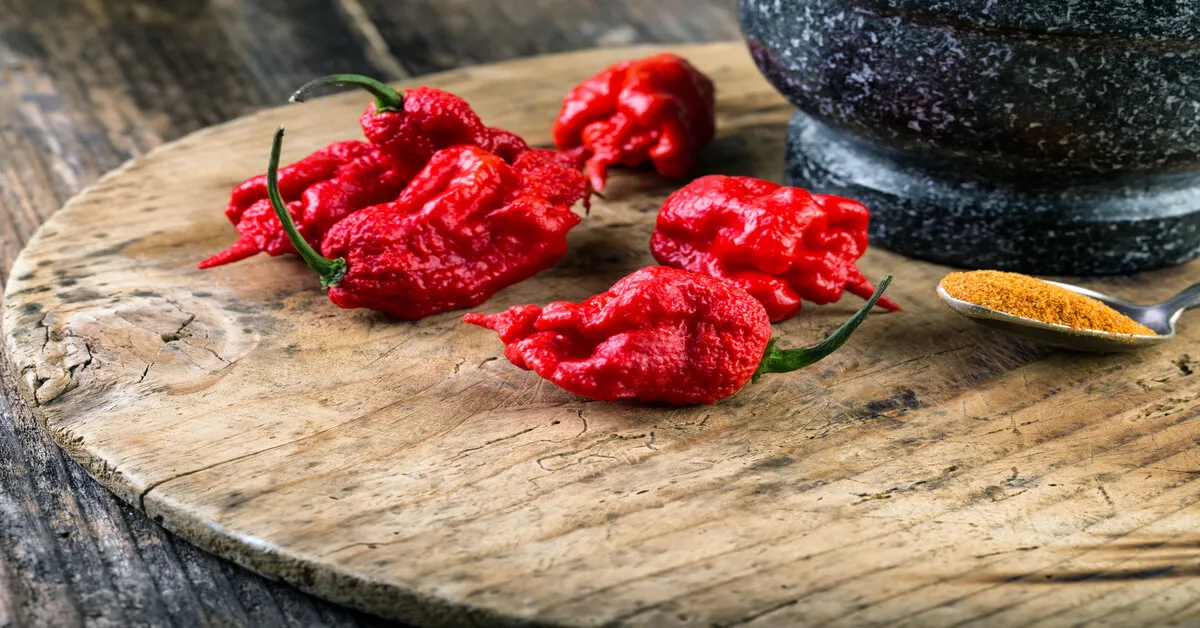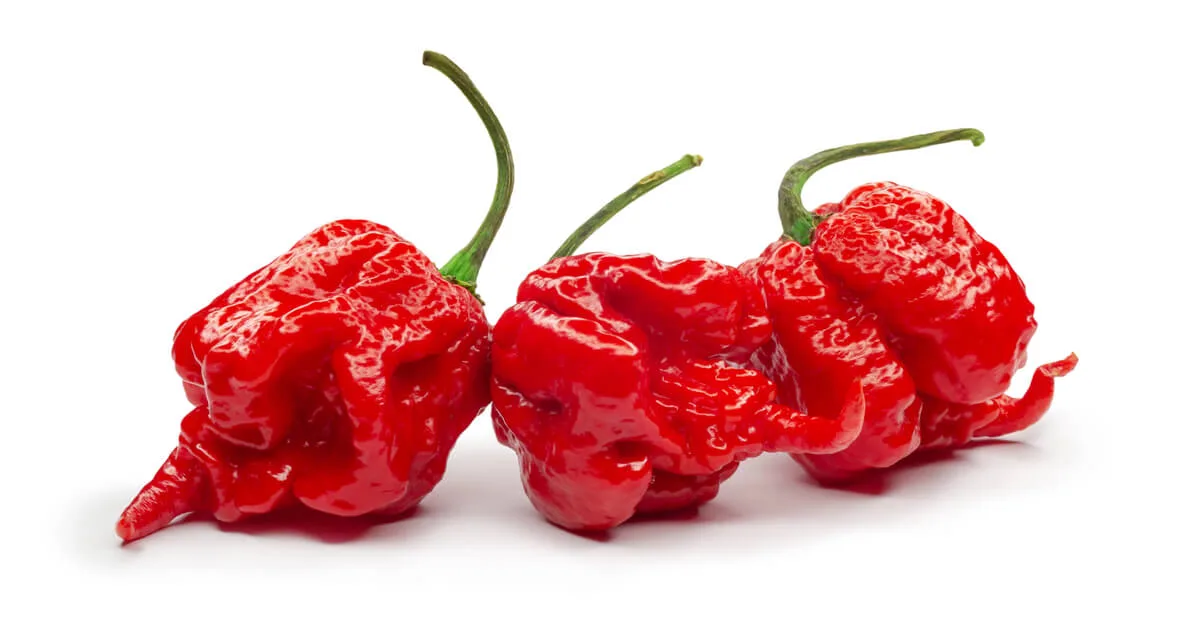Some of the links in this post are affiliate links. This means if you click on the link and purchase the item, I will receive an affiliate commission at no extra cost to you.
The Carolina Reaper pepper is a cultivar of Capsicum chinense species, the spiciest of the five commonly cultivated pepper species.
Other familiar relatives within the same species include the habanero and Bhut Jolokia peppers.
However, none of these other peppers come close to the spiciness of the Carolina Reaper, which holds the current record for the “world’s spiciest chili pepper.”
The taste is often described by enthusiasts as having a fruity, sweet taste with notes of cinnamon and chocolate undertones.
However, these peppers are so hot that they’ve been known to send people to the hospital, so beware of the dangers!
Carolina Reaper Origin
The Carolina Reaper pepper was bred by American chili pepper breeder Ed Currie from South Carolina.
It overtook the “Trinidad Scorpion Butch T” pepper from Australia, the previous record holder, to claim the title of the “world’s hottest chili pepper” by the Guinness Book of World Records in 2013.
A hybrid between St. Vincent’s “La Soufriere” pepper and the Pakistani Naga pepper, the Carolina Reaper took over twelve years to develop and stabilize. [1]
How hot is a Carolina Reaper Pepper?

Considered the spiciest pepper in the world, the Carolina Reaper clocks up to 2.2 million Scoville Heat Units (SHU), making it up to 22x hotter than your already spicy habanero.
However, pepper spiciness can range depending on the fruit and growing conditions, so the Carolina Reaper’s spiciness ranges between 1,400,000 – 2,200,000 SHU, averaging about 1.56 million SHU.
For comparison, ghost chilis have a SHU value of 850,000-1,000,000, habaneros 150,000-350,000 SHU, Thai chilies 50,000-100,000 SHU, cayenne peppers 30,000 SHU, serranos 10,000-25,000 SHU, jalapeños 3,000-8,000 SHU, and bell peppers 0 SHU. [2]
Pepper Joe’s Carolina Reaper Seeds – Pack of 10+ World’s Hottest Chili Pepper Seeds – USA Grown – Premium Non-GMO
Carolina Reaper Plant Care
The Carolina Reapers are warm-season, frost-tender perennial plants that thrive in full sun and organic-rich soils.
Carolina Reapers can be planted directly into the ground or in a fairly large container, where they will grow up to five feet (1.5 m) tall and four feet (1.2 m) wide.
If planting in rows, space them 3-4 feet (0.9-1.2 m) between other plants to ensure plenty of room for plants to grow and that you don’t accidentally graze against the hot oils when harvesting.
Below, we’ll go over everything else you need to know about cultivating this extreme heat variety.
Soil
Carolina Reapers thrive in moist, rich, well-draining, slightly acidic pH 6.0-6.5, and loam soil.
If there are drainage issues in your garden, consider growing in a raised garden bed.
Watering
Like most peppers, Carolina Reapers require about 1-2 inches of water weekly.
Deep and infrequent watering with drip irrigation or a soaker hose should help avoid wet leaves, which invite disease and pests.
According to several studies, water-stressed peppers produce higher concentrations of capsaicin, which increases the pepper’s overall pungency and spiciness. [3]
To make your peppers even spicier, decrease the amount of watering when there is fruit on the plant.
Lighting
Like other peppers, Carolina Reapers do best in full sun (about 6-8 hours of direct sunlight).
A south-, west-, or east-facing window or slope ensures maximum light exposure.
Some shading may be necessary if temperatures exceed 95°F (35°C) regularly.
Humidity & Temperature
Ideal daytime temperatures for Carolinas and other peppers are between 70-85°F (21-29°C) and 50-60°F (10-15°C) at night.
Temperatures below 55°F (13°C) may stunt or kill plants, and temperatures above 95°F (35°C) may prevent germination and cause blossom drop or heat stress.
Carolina Reapers thrive in relative humidity between 50-70%.
Fertilizing (NPK)
Carolina Reapers produce better yields and fruiter spicier fruit with regular fertilization.
Fertilize with NPK 5-10-10 (half as much nitrogen as other nutrients) fertilizer during transplanting and again every 2 to 4 weeks after.
When fruits begin to set, switch to a potassium 9-15-30 fertilizer to reduce foliage growth and encourage crop development.
For a more organic approach, use green sand, kelp meal, fish emulsion, or bone meal.
Diseases & Pests
Carolinas are prone to several diseases which commonly affect nightshade plants such as mosaic virus, verticillium wilt, anthracnose, phytophthora blight, Cercospora leaf spot, wet rot, southern blight, blossom-end rot, and tomato spotted wilt virus.
Bacterial leaf spot is very common and may potentially be deadly, so avoid this common pepper disease by keeping leaves dry and treating them with a copper-based spray.
Avoid planting Reapers and other peppers after planting crops such as beets, tomatoes, beans, or spinach to avoid diseases and nutrient depletion.
Watch out for insects such as white flies, aphids, cutworms, pepper maggots, flea beetles, mites, leafminers, pepper weevils, thrips, tomato fruit worms, and spider mites, among other pepper pests. They don’t seem to be bothered by the pepper’s spice.
To control pests, use Insecticidal soap or horticultural oils such as neem oil.
Days to maturity
Carolina Reapers can take between 100-150+ days from seed to mature fruit, depending on environmental and cultural factors.
In general, Carolina Peppers will take a bit longer than other chili peppers to produce ripe fruit.
Scoville scale
The Scoville scale measures how many times the capsaicin oil found in chili peppers must be diluted before the spiciness levels are undetectable by a panel of tasters.
The higher the Scoville Heat Unit (SHU), the spicier the pepper.
Carolina Reapers have a SHU value of between 1,400,000 – 2,200,000 SHU, averaging about 1.56 million SHU.
Carolina Reaper Plant Stages

For a timelapse of Carolina Peppers from seed to mature plant, see this video.
In general, Carolina Peppers will go through the below stages:
- Germination (0-14 days) – Soil temperatures should be between 70-95°C (21-35°C) for seeds to emerge. Seeds may not germinate if temperatures are below 55°F (13°C). By day 14, the first two true sets of leaves should have emerged. Water after seeding.
- Adolescent (14-30 days) – Several sets of true leaves will develop. At this stage, transfer plants into a pot or the ground if growing from seed trays. Water after transplanting.
- Growth (30-80 days) – Pay attention to watering and feeding needs during this rapid growth stage. Prune early flower buds at this stage to encourage more leafy growth.
- Flowering (80-120 days) – At this stage, white or yellow fruit blossoms should begin to develop. Once peppers start to form, switch to a high-phosphorus low-nitrogen fertilizer.
- Fruiting and Ripening (120-150+ days) – Successfully fertilized flowers will drop petals and light-green wrinkly peppers should slowly start to emerge. Fruits will ripen from light green to yellow before turning bright orange or red.
How to Grow Carolina Reaper Peppers from Seed
To grow Carolina Reapers from seeds, place dry seeds ¼ inch (0.6 cm) gently into the growing media.
Start seeds in germination trays or small containers with holes at the bottom before transplanting to a larger pot or outside.
If growing indoors, sow seeds 6-10 weeks before the last frost date to get a head start.
Keep soils moist and warm, and water gently after seeding. A grow light or heat mat will help encourage germination.
Wait for soil temperatures to be above 65°F (18°C) degrees and for several sets of true leaves to form before transplanting.
To help your plants adjust to the outside, harden them off over a two week period.
Growing Carolina Reaper in Pots
To grow Carolinas in pots, use a large pot at least 14 inches (35 cm) deep and 12 inches (30 cm) across. A 5-gallon (or 19-liter) or above container should be large enough.
Use a clay pot for better drainage and a quality potting mix that allows water to drain properly. Avoid soggy soils.
Harvesting Carolina Reaper Peppers

Carolina Reapers will typically turn yellow before ripening to an orange or bright ruby-red color.
Mature fruit will look shiny and wrinkly like sundried tomatoes, but appear firm with a scorpion tail hook at the bottom.
Avoid touching any part of the plant, as the hot oils have been known to soak through two layers of gloves.
The capsaicin levels found in Carolina Reapers are extremely potent and can cause extreme discomfort, diarrhea, vomiting, and migraines requiring hospitalization.
Pets like cats, dogs, and other mammals should be kept from eating Carolina Pepper plants, as they will experience similar symptoms described above.
Use clippers to separate peppers from the plant. Avoid yanking with your hand, as this can damage branches and spread hot oil.
Harvest when peppers are dry to avoid spreading diseases.
Like other peppers, Carolinas are indeterminate, so picking green peppers early will encourage more fruiting and bigger fruits on the remaining crop.
Carolina peppers will stay fresh for 3-5 days when stored at room temperature, and they will last 3-5 weeks if stored in your fridge’s crisper (~45-50°F or 7-10°C) at 95% relative humidity.
Freezing or pickling will also help them keep even longer, or consider making a spicy sauce.
References:
[1] Zucchino, D. (2014, November 29). From pot to hot: How a grower produced world’s most fiery chile pepper. Los Angeles Times.
[2] Reiners, S. (2021, June 2). Pepper Secrets. Cornell College of Agriculture and Life Sciences.
[3] Ruiz-Lau, N. (2011, March 1). Water Deficit Affects the Accumulation of Capsaicinoids in Fruits of Capsicum chinense Jacq. Hortsci.

